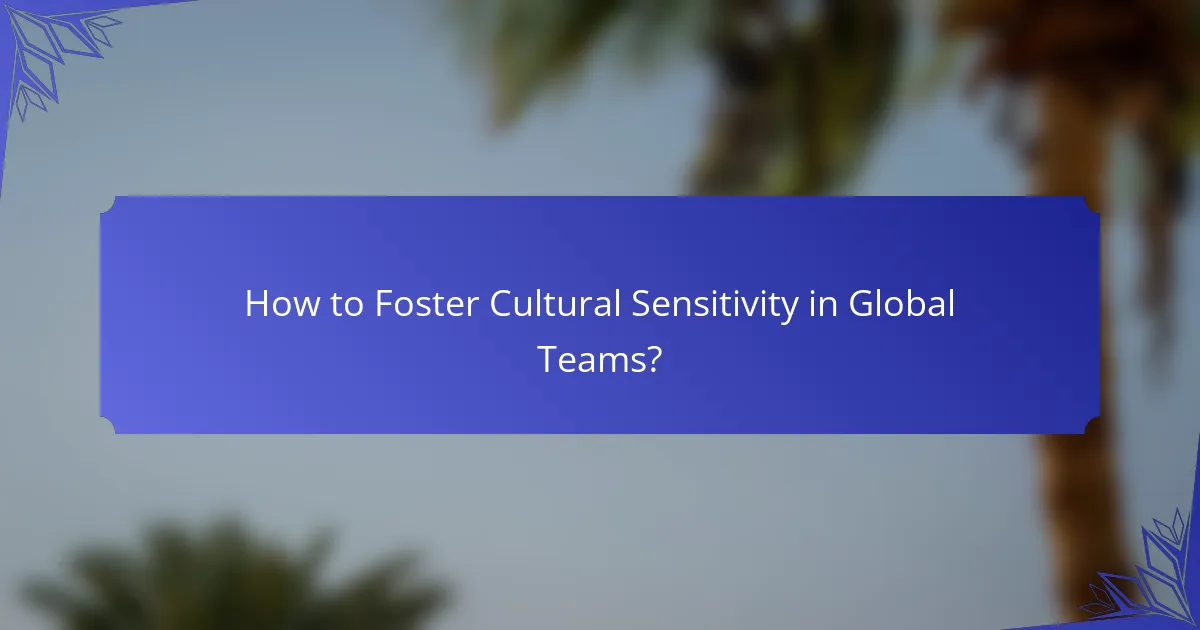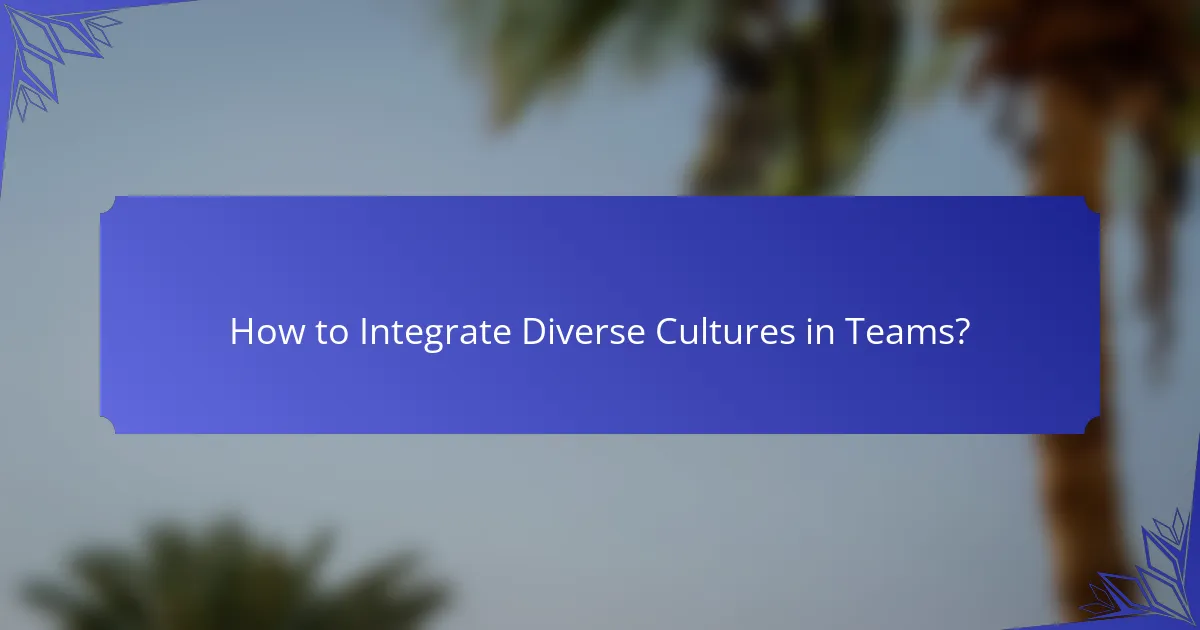Cultural sensitivity is essential for the success of global teams, as it enhances awareness, communication, and integration among members from diverse backgrounds. By implementing structured training and inclusive policies, teams can foster an environment of respect and collaboration, ultimately leading to more effective teamwork and innovation.

How to Foster Cultural Sensitivity in Global Teams?
Fostering cultural sensitivity in global teams involves implementing strategies that enhance awareness, communication, and integration among diverse members. This can be achieved through structured training, ongoing workshops, inclusive policies, mentorship, and effective feedback mechanisms.
Training programs
Training programs are essential for educating team members about cultural differences and promoting sensitivity. These programs should cover topics such as communication styles, cultural norms, and conflict resolution strategies.
Consider offering both online and in-person training sessions to accommodate different learning preferences. Regularly updating the content to reflect current global trends can keep the training relevant and engaging.
Regular workshops
Regular workshops provide a platform for team members to share experiences and discuss cultural challenges. These interactive sessions can help build trust and understanding among team members from various backgrounds.
Workshops can include role-playing scenarios, case studies, and group discussions to encourage participation. Scheduling these workshops quarterly can ensure ongoing engagement and learning.
Inclusive policies
Inclusive policies are vital for creating a supportive environment in global teams. These policies should address recruitment, promotion, and workplace behavior to ensure all employees feel valued and respected.
Implementing a zero-tolerance policy for discrimination and harassment can reinforce a culture of respect. Regularly reviewing and updating these policies in consultation with team members can enhance their effectiveness.
Mentorship initiatives
Mentorship initiatives pair experienced team members with those from different cultural backgrounds to facilitate knowledge sharing and personal growth. This relationship can help mentees navigate workplace dynamics and develop their professional skills.
Encouraging mentors to share their cultural insights can deepen understanding and foster connections. Establishing clear goals for mentorship relationships can enhance their impact and effectiveness.
Feedback mechanisms
Effective feedback mechanisms allow team members to express their thoughts on cultural sensitivity initiatives. Regular surveys and suggestion boxes can provide valuable insights into team dynamics and areas for improvement.
Encouraging open dialogue about cultural experiences can lead to actionable changes. It’s important to ensure that feedback is taken seriously and acted upon to demonstrate commitment to fostering cultural sensitivity.

What Are Effective Communication Strategies?
Effective communication strategies in global teams involve active listening, clear messaging, visual aids, and language support tools. These strategies enhance understanding and collaboration among team members from diverse cultural backgrounds.
Active listening techniques
Active listening techniques are essential for ensuring that all team members feel heard and valued. This involves focusing fully on the speaker, acknowledging their message, and responding thoughtfully. Techniques such as paraphrasing what has been said or asking clarifying questions can significantly improve comprehension.
To practice active listening, avoid interrupting and give verbal affirmations like “I see” or “That makes sense.” This encourages a more open dialogue and fosters trust within the team.
Clear messaging
Clear messaging is crucial in preventing misunderstandings in a multicultural environment. Use simple, direct language and avoid idioms or jargon that may not translate well across cultures. Aim for concise messages that convey the core idea without unnecessary complexity.
Consider using bullet points for key information to enhance clarity. This approach allows team members to quickly grasp essential points, reducing the risk of miscommunication.
Use of visual aids
Visual aids can bridge language gaps and enhance understanding in global teams. Charts, graphs, and infographics can convey complex information more effectively than text alone. They provide a universal language that can be understood regardless of linguistic proficiency.
When using visual aids, ensure they are culturally appropriate and accessible. For instance, color choices can have different meanings in various cultures, so select visuals that resonate positively with all team members.
Language support tools
Language support tools, such as translation apps and software, can facilitate communication in diverse teams. These tools help team members who may not be fluent in the primary language of communication to participate fully. Popular options include Google Translate and Microsoft Translator, which offer real-time translation features.
However, it’s important to recognize that machine translations may not always capture nuances. Encourage team members to verify translations and clarify any ambiguous terms to ensure accurate understanding.

How to Integrate Diverse Cultures in Teams?
Integrating diverse cultures in teams involves fostering understanding and collaboration among team members from different backgrounds. This can be achieved through intentional strategies that promote inclusivity and respect for cultural differences.
Team-building activities
Team-building activities are essential for integrating diverse cultures as they encourage collaboration and trust among team members. Consider activities that require teamwork, such as problem-solving tasks or outdoor challenges, which can help break down cultural barriers.
When planning these activities, ensure they are culturally sensitive and inclusive. For example, avoid activities that may conflict with certain cultural practices or beliefs. Aim for a mix of physical and mental challenges to cater to various preferences.
Cultural exchange programs
Cultural exchange programs allow team members to share their backgrounds and experiences, enhancing mutual understanding. These programs can include job shadowing, mentorship, or even short-term assignments in different cultural settings.
Implementing a cultural exchange requires careful planning. Set clear objectives, such as improving communication or fostering innovation, and provide resources for participants to learn about each other’s cultures. This can lead to greater empathy and collaboration within the team.
Celebration of cultural events
Celebrating cultural events is a powerful way to integrate diverse cultures within a team. Organizing events like Lunar New Year, Diwali, or Thanksgiving can create opportunities for team members to share their traditions and values.
To maximize participation, consider hosting potluck-style gatherings where team members bring dishes from their cultures. This not only promotes inclusivity but also encourages conversations about cultural significance, fostering a deeper appreciation among team members.

What Are the Benefits of Cultural Sensitivity?
Cultural sensitivity fosters an inclusive environment that enhances team dynamics and overall effectiveness. By recognizing and respecting diverse backgrounds, organizations can unlock numerous advantages that contribute to success in a global marketplace.
Improved collaboration
Cultural sensitivity leads to better collaboration among team members by promoting mutual respect and understanding. When individuals appreciate each other’s cultural backgrounds, they are more likely to communicate openly and share ideas, resulting in a more cohesive team environment.
To enhance collaboration, teams can implement regular cultural awareness training and encourage open discussions about cultural differences. This proactive approach helps prevent misunderstandings and builds trust among team members.
Enhanced creativity
A culturally sensitive workplace encourages diverse perspectives, which can significantly boost creativity. When team members from various backgrounds contribute their unique viewpoints, it often leads to innovative solutions and fresh ideas.
Organizations can harness this creativity by forming diverse project teams and fostering an environment where all ideas are valued. Regular brainstorming sessions that celebrate cultural diversity can further stimulate creative thinking.
Increased employee satisfaction
Cultural sensitivity contributes to higher employee satisfaction by creating an inclusive atmosphere where everyone feels valued. When employees see their cultural identities respected, they are more likely to feel engaged and committed to their work.
To promote satisfaction, companies should actively seek feedback from employees about their experiences and perceptions of cultural inclusivity. Implementing changes based on this feedback can enhance overall morale and retention rates.
Better conflict resolution
Cultural sensitivity equips teams with the tools to address and resolve conflicts more effectively. Understanding cultural differences can help team members navigate disagreements with empathy and respect, leading to more constructive outcomes.
To improve conflict resolution, teams should establish clear communication channels and encourage open dialogue about cultural misunderstandings. Training in conflict resolution strategies that consider cultural contexts can also be beneficial in maintaining harmony within the team.

What Challenges Do Global Teams Face?
Global teams encounter various challenges that can hinder collaboration and productivity, primarily due to cultural differences and communication barriers. Understanding these obstacles is crucial for fostering effective teamwork across diverse backgrounds.
Miscommunication risks
Miscommunication is a significant risk in global teams, often arising from language barriers and differing communication styles. For example, directness may be valued in some cultures, while others may prefer a more indirect approach, leading to misunderstandings.
To mitigate these risks, teams should establish clear communication protocols, such as using simple language and confirming understanding through paraphrasing. Regular check-ins can also help clarify any ambiguities that arise during discussions.
Bias and stereotypes
Bias and stereotypes can undermine team dynamics and lead to conflicts within global teams. Preconceived notions about a culture can affect how team members interact and collaborate, potentially resulting in exclusion or resentment.
To combat bias, it is essential to promote cultural awareness and sensitivity training. Encourage team members to share their cultural backgrounds and experiences, fostering an environment of respect and understanding. Regularly revisiting team norms can also help challenge and reduce stereotypes.


